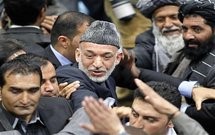 The announcement of a drawdown timeline for US troops from Afghanistan predictably garnered mixed reactions. However, most of the issues that brought the US-led ISAF to the region still remain unresolved. Where on one hand Osama bin Laden’s killing is an ace for the US, the al Qaeda as an entity still remains.
The announcement of a drawdown timeline for US troops from Afghanistan predictably garnered mixed reactions. However, most of the issues that brought the US-led ISAF to the region still remain unresolved. Where on one hand Osama bin Laden’s killing is an ace for the US, the al Qaeda as an entity still remains.
This leaves the second spoiler, the Afghan Taliban, as well as their faith brothers, Tehreek-e-Taliban Pakistan (TTP). Both of them have the advantage of being sons of the soil. There is no timeline to chase, so they have the luxury to act as spoilers, keep the security profile turbulent in real time and wait for the ‘foreigners’ to exit. Though the Afghan Taliban has suffered significant losses, their structures, ability to recruit, and countrywide operations remain intact with new tactics and means to hold ground.
Afghanistan today is not the one left in the wake of the Soviet withdrawal and the faulty Geneva Accords. This is good news, as even in the worst-case future scenario, one cannot envision the international community leaving Kabul in the lurch. However it correspondingly gives rise to another problem: that too many actors with vested interests will turn Afghanistan into their proxy strategic playfield. For the moment, Afghans are happy with this international focus and seemingly positive attention, but the years to come may change this happy picture. A larger chunk of Afghan civil society, which is highly proactive in democratic nation-building, is drawn from the Afghan diaspora, who despite their best intentions may not be able to withstand a possible surge in militancy and violence in case a situation so arises. The law enforcement and security apparatus, ANSF, though much improved and stronger than before still has a long way to go and its performance post transition would at best remain a mixed bag, which given Afghanistan’s complex security dynamics, is not at all a good news. That leaves the ‘Afghan-owned and Afghan-led’ democratic and nation-building process, which like many of the ‘Made in US’ products leaves much to be desired. In a cross-section of Afghan nationals, there exists deep skepticism about the ‘Afghan-owned’ component largely missing from the frame, thus once again constructing a system that has very weak foundations.
Much depends on the results of the forthcoming elections. With all the presidential candidates and their affiliates minus incumbent president Karzai consenting to the Bilateral Security Agreement (BSA), Afghanistan requires a strong representative government with indigenous legitimacy and capacity to extend its writ outside Kabul without external props. Will the Taliban be willing to negotiate and agree to some non-violent power-sharing? There are serious doubts. What would be the impact of these developments on Pakistan? Though the Pakistani government is already in talks with the TTP (Pakhtun faction) and there is a temporary respite from the US drones, bombings and civilian killings have not reduced and nor has the US announced a complete termination of its drone attack policy. In fact most of the Taliban high shura has comfortably crossed over into Afghanistan and will remain there for as long as it suits them. Though the Afghan and Pakistani Taliban are pursuing their independent agenda, one must not forget their past links and the strength and resilience of their networks. In addition, the history of Pak-US relations is highly checkered, and even after eleven plus years, Pakistani society remains highly divided about whether this has been Pakistan’s war.
In case the talks with the TTP fail and there is a breach in the security framework that would result as a part of the agreement, would post-2014 Afghanistan be able to provide security cooperation to Pakistan, mainly in the shape of border closure, hot pursuit into ‘friendly’ territory to capture militants, intelligence-sharing and perceivable joint operations? With divergent perspectives and a strong sense of the other side being the spoiler, there is doubt that such a cooperative security regime could work. However, for the Afghan and Pakistan Taliban, the post 2014 timeline would actually be a welcoming notion. So long as there is an American security interest and presence, there is optimism for a better security framework. Both Pakistan and Afghanistan can conveniently dump their bad diplomacy on the US. It also acts as a balancer against a stronger Indian presence.
Though Pakistani decision-makers have reinforced the point that they have no reservations with New Delhi’s ‘legitimate’ interests in Afghanistan, they would always remain wary of any military or strategic role India has in Afghanistan. Realistically, every country, be it the US (Monroe doctrine) or India (Nepal, Bhutan), has similar concerns when it comes to its strategic interests. Afghanistan of the future holds increased economic and commercial activity and corresponding involvement of the international community, as well as pressure for increased transit and trilateral (India-Pakistan-Afghanistan) trade. Pakistan has to prepare itself for the changing trends and pressures. Ironically, the energy pipelines still remain somewhat elusive; a problematic profile for energy-stressed Pakistan specifically. The coming months are fraught with multiple challenges that need a sustainable, well-articulated and well thought-out approach. The 2014 exit timeline in fact heralds a new chapter in the region’s strategic relations, which would largely shape future dynamics.
By Special Arrangement with Institute of Peace and Conflict Studies (http://www.ipcs.org)